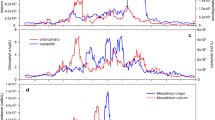Abstract
Blooms of the toxic dinoflagellate Alexandrium tamarense Lebour have been nearly annual features along the coasts of southern Maine, New Hampshire and Massachusetts, USA, since 1972. In 1990 two hypotheses which have been used to explain the initiation of these blooms in the southwestern portion of the Gulf of Maine were tested using historical records of shellfish toxicity, wind, and river flow. The first hypothesis states that the blooms were initiated or advected to shore by wind-driven coastal upwelling. The second states that established blooms were advected from north to south alongshore in a coastally trapped buoyant plume of water. Of the eleven years examined (1979 to 1989), we found seven cases inconsistent with the wind-driven upwelling hypothesis, and only one case (1985) which contradicts the plume-advection hypothesis. 1985 was an unusual year in many respects, and we suggest that some other mechanism was responsible for the toxic outbreaks. In addition, the wind-driven upwelling hypothesis could not explain the observed north-to-south temporal progression of toxicity each year. The plume-advection hypothesis was found to best explain the datails of the timing and spread of shellfish toxicity in Gulf of Maine waters to the south of Penobscot Bay, Maine. These include the variable north-to-south progression with time, the presence of a toxin-free zone south of Cape Ann, Massachusetts, the sporadic nature of toxic outbreaks south of Massachusetts Bay, and the apparently rare occurrence of high toxicity levels well offshore on Nantucket Shoals and Georges Bank.
Similar content being viewed by others
Literature cited
Association of Official Agricultural Chemists (1965). Paralytic shellfish toxin, biological methods. (18). In Official methods analysis, 10th edn. A.O.A.C., Washington, D. C., p. 282–284
Bormans, M., Garrett, C. (1988). A simple criterion for gyre formation by the surface outflow from a strait, with application to the Alboran Sea. J. geophys. Res. 94:12637–12644
Bricelj, M., Lee, J. H., Cembella, A. D., Anderson, D. M. (1990) Uptake of Alexandrium fundyense by Mytilus edulis and Mercenaria mercenaria under controlled conditions. In: Graneli, E., Sundstrom, B., Edler, L., Anderson, D. (eds.) Toxic marine phytoplankton, Elsevier, New York, p. 269–274
Butman, B. (1976). Hydrography and low-frequency currents associated with the spring runoff in Massachusetts Bay. Mém. Soc. r. Sci. Liège 6(X):247–275
Chao, S.-Y.(1988). River-forced estuarine plumes. J. phys. Oceanogr. 18:72–88
Clarke, A. J.,Brink, K. H. (1985). The response of a stratified, frictional flow of shelf and slope waters to fluctuating largescale, low-frequency wind forcing. J. Phys. Oceanogr. 15:439–453
Franks, P. J. S. (1990). Dinoflagellate blooms and physical systems in the Gulf of Maine. Ph. D. thesis, MIT/WHOI Joint Program in Oceanography, Woods Hole, Massachusetts
Franks, P. J. S., Anderson, D. M. (1992). Alongshore transport of a toxic phytoplankton bloom in a buoyancy current: Alexandrium tamarense in the Gulf of Maine. Mar. Biol. 112:153–164
Gainey, L. F., Shumway, S. E. (1988). A compendium of the responses of vivalve molluscs to toxic dinoflagellates. J Shellfish Res. 7:623–628
Hartwell, A. D. (1975). Hydrographic factors affecting the distribution and movement of toxic dinoflagellates in the western Gulf of Maine. In: LoCicero, V. R. (ed.) Proceedings of the first international conference on toxic dinoflagellate blooms, Massachusetts Science and Technology Foundation. Wakefield, Massachusetts, p. 47–68
Hopkins, T. S., Garfield, N. (1981). Physical origins of Georges Bank water. J. mar. Res. 39:465–500
Hurst, J. W. (1979). Shellfish monitoring in Maine. In: LoCicero, V. R. (ed.) Proceedings of the first international conference on toxic dinoflagellate blooms, Massachusetts Science and Technology Foundation, Wakefield, Massachusetts, p. 23–40
Hurst, J. W., Selvin, R., Sullivan, J. J., Yentsch, C. M., Guillard, R. L., (1985). Intercomparison of various assay methods for the detection of shellfish toxins. In: Anderson, D., White, A., Baden, D. (eds.) Toxic dinoflagellates. Elsevier, New York, p. 427–432
Janowitz, G. S., Pietrafesa, L. J. (1980). A model and observations of time-dependent upwelling over the mid-shelf and slope. J. phys. Oceanogr. 10:1573–1583
Kao, T., Pao, H.-P., Park, C. (1978). Surface intrusions, fronts, and internal waves: a numerical study. J. geophys. Res. 83:4641–4650
Large, W. S., Pond, S. (1981). Open ocean momentum flux measurments in moderate to strong winds. J. phys. Oceanogr. 11:324–336
Levy, G., Brown, R. A. (1986). A simple, objective analysis scheme for scatterometer data. J. geophys. Res 91:5153–5158
Limeburner, R., Beardsley, R. C. (1982). The seasonal hydrography and circulation over Nantucket Shoals. J. mar. Res. 40 (suppl.): 371–405
Martin, C., Main, J. M. (1981). Toxic dinoflagellate blooms (red tides) and shellfish resources in Plum Island Sound and adjacent Massachusetts waters. Final report to the Town of Ipswich, Massachusetts, under UMass/Amherst OGCA Contract No. 80A613. Office of Coastal Zone Management, NOAA, Washington D.C.
Mulligan, H. (1973). Probable causes for the 1972 red tide in the Cape Ann region of the Gulf of Maine. J. Fish. Res. Bd. Can. 30:1363–1366
Mulligan, H. (1975). Oceanographic factors associated with New England red tide blooms. In: Lo Cicero, V. R. (ed.) Proceedings of the first international conference on toxic dinoflagellate blooms. Massachusetts Science and Technology Foundation, Wakefield, Massachasetts, p. 23–40
Seliger, H., Tyler, M. A., McKinley, K. P. (1979). Phytoplankton distributions and red tides resulting from frontal circulation patterns. In: Taylor, D. L., Seliger, H. H. (eds.) Toxic dinoflagellate blooms. Elsevier, New York, p. 239–248
Shumway, S., Sherman-Caswell, S., Hurst, J. W. (1988). Paralytic shellfish poisoning in Maine: monitoring a monster. J. Shellfish Res. 7:643–652
Steidinger, K. A., Moestrup, Ø. (1990). The taxonomy of Gonyaulax, Pyrodinium, Alexandrium, Gessnerium, Protogonyaulax and Gonniodoma.In: Graneli, E., Sundstrom, B., Edler, L., Anderson, D. (eds.) Toxic marine phytoplankton. Elsevier, New York, p. 522–523
Author information
Authors and Affiliations
Additional information
Communicated by J. Grassle, New Brunswick
Rights and permissions
About this article
Cite this article
Franks, P.J.S., Anderson, D.M. Toxic phytoplankton blooms in the southwestern Gulf of Maine: testing hypotheses of physical control using historical data. Marine Biology 112, 165–174 (1992). https://doi.org/10.1007/BF00349740
Accepted:
Issue Date:
DOI: https://doi.org/10.1007/BF00349740




